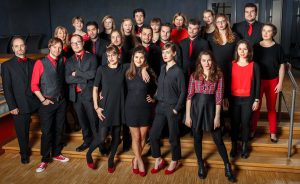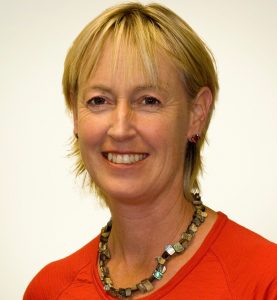People and the Land: A Theme of our Time
As you all know by now, and to our deep regret, the 12th World Symposium on Choral Music in Auckland,
New Zealand, had to be cancelled because of the COVID19 pandemic.
We would like to express our profound and sincere thanks to all the people involved in the preparation of
this event. They did an outstanding job which, we believe, will not have been in vain. Their experience will
most certainly be of use in future IFCM events.
IFCM President and Board
The article below was written (and translated) before the cancellation of the event. However, we decided to
publish it because it gives a good picture of the spirit and program of the symposium.
*****************
By Christine Argyle
Choosing the theme for a world symposium on choral music must typically involve lengthy debate over a multitude of possible topics. But for John Rosser (Artistic Director of the 12th World Symposium on Choral Music) and the New Zealand Choral Federation, the choice for WSCM2020 was not a difficult one. You might say it came naturally.
‘He tangata / He whenua – People and the Land’ is derived from tangata whenua (literally ‘people of the land’), the name the indigenous Māori of Aotearoa New Zealand use to refer to themselves. The term tangata whenua is widely used and understood by New Zealanders of all cultures, and implicit in it is the concept of kaitiakitanga – the guardianship and protection of sky, sea and land. In the Māori world view, land gives birth to all things, including humankind, and provides the physical and spiritual basis for life.
A statement on the Symposium website reads, “In WSCM2020 we want to explore through choral music the relationship humans have with the land that supports them: the sense of identity they derive from it and the tensions that arise out of it. We believe this is a theme that touches all of us in some way, calling to mind such notions as family, nurture, identity, place, community, culture, celebration, nationalism, colonialism, dispossession, alienation, partnership, freedom, development, interconnectedness, environmentalism, urban living, the natural world, the seasons, stress and healing, beauty, nostalgia, utopia…”
One need look no further than the great Romantic composers to find a rich repertoire of choral works inspired by nature and the human condition, and there are numerous examples from the eras before and since. But many of the choirs travelling to New Zealand for WSCM2020 have chosen to commission new works exploring the relationship between people and land, while others have delved into the traditional music of their country’s indigenous cultures for inspiration. The rich and varied responses to the theme have resulted in innovative and thought-provoking programmes that cannot fail to engage and delight delegates and audiences of all backgrounds and tastes.
A newly-commissioned work to be performed by the Stuttgart Chamber Choir under Frieder Bernius is The Silent City by Michael Ostrzyga, one of the featured presenters at WSCM2020. This a cappella piece evokes the awe-inspiring landscape of Bryce Canyon and explores the human response to this unique environment, including a reference to the creation myth of an indigenous Paiute tribe. Ostrzyga employs a text-collage ranging from words in Paiute to contemporary poetry and incorporates overtone singing by Anna-Maria Hefele (also presenting at WSCM2020).
Dominick DiOrio, director of NOTUS Contemporary Vocal Ensemble, has responded to the theme with two very different works of his own. He writes, “When I began to think about ‘People and the Land’, I could not help but consider that so many people at this time in our world history are being displaced from the lands that they have long called home. Refugees across the world are in crisis, fleeing persecution in their ancestral home to seek out new homes elsewhere. It is impossible to sing about the land without considering this plight.” He describes his piece You Do Not Walk Alone (2014) as “a reassuring balm for those that flee”. In A Dome of Many-Coloured Glass (2010), DiOrio says “the vast expanses of nature are front and centre, with the poetry of Amy Lowell evoking images of the sea, the stars, and the mountains as representatives of our great Gaia, the Earth”.

The concept of Gaia – the ancestral mother of all life – is a recurring theme in WSCM2020 programmes. My Mother the Earth by Frank Harvøy (presenting at WSCM2020) brings a Nordic perspective to the notion of Mother Nature in the programme of the Norwegian National Youth Choir and Nordic Voices, while Mexican ensemble Voz en Punto will open their full-length concert with Xochipitzahuatl, a song to Mother Earth in the language of the Aztecs. Ensemble Vocapella Limburg’s programme will include Papatūānuku by New Zealand/English composer Chris Artley. In the Māori creation myth, Papatūānuku, the earth mother, had many children with the sky father Ranginui, but they loved each other so much that earth and sky remained locked in an embrace that kept all light out. Eventually their children forced them apart so that light and air could allow forests, seas, birds, fish and animals to flourish.
The New Zealand Youth Choir looks not to Māori legend, but to Māori history and battles over land in a moving choral arrangement by Robert Wiremu (a WSCM2020 presenter) of Tuirina Wehi’s Waerenga-a-Hika. The piece commemorates an episode in New Zealand’s land wars: the 1865 siege by colonial forces of a fortified Māori settlement, which resulted in significant loss of life and the capture and deportation of those that survived.
Similar events across the sea in Australia inspired Paul Stanhope’s Jandamarra: Sing for the Country. The work honours an Aboriginal resistance hero from the 1890s who fought white settlers and police in order to protect his native Bunuba people and their country from invasion. The final movement of the work, ‘This is our Home’, features in the programme of Australia’s Gondwana Children’s Choir, along with Songs of the Torres Strait Islands, traditional songs of the inhabitants of the archipelago that lies between the northernmost peninsula of Australia and New Guinea.
Africa and its people are represented in concerts by the Nairobi Chamber Chorus – from songs of the Luo, Digo and Giriama communities in Kenya, to traditional songs from Namibia, Nigeria and Liberia – while the Müller Chamber Choir of Taiwan has a diverse programme that ranges from Seppo Paakkunainen’s Dalvi duoddar luohti, based on a Yoik melody from Finland and incorporating traditional throat singing, through to a hunting song of the indigenous Bunun tribe in Taiwan, known for their improvised polyphonic vocal music.
The Houston Chamber Choir’s director Robert Simpson says, “People and the Land is a theme that has deep meaning for those in Texas. Traveling through its 268,597 square miles, one finds forests, wetlands, rolling hills and plains. Rich in Native American and Hispanic culture, Texas also identifies strongly with the heritage of its many German, Czech and Polish settlers who came to establish ranches and farms. The land is part of the people of Texas.” The choir will sing a work dedicated to them by American composer Pierre Jalbert called Desert Places, featuring texts by Robert Frost, Sappho, and Walt Whitman that speak of the human soul’s interaction with forces from the outside world.
Ethan Sperry, director of Portland State Chamber Choir, has used the Symposium theme as the inspiration for two quite different concerts. The first, titled ’Legends of Rebirth‘, features his own choral arrangements of pieces inspired by the cycle of seasons and the cycle of life from Native American, Hindu, and Haitian Voudo traditions, as well as a work by Ēriks Ešenvalds based on a Hindu creation myth. In their second concert, the choir will present a major work: The Consolation of Apollo by Kile Smith. Sperry says, “In 1968 the world watched in awe as the Apollo 8 spacecraft broadcast the first images of the Earth rising over the moon. This new choral piece combines the words of the Apollo 8 astronauts, as they rounded the moon and saw Earth rise for the first time, with text by the medieval scholar Boethius contemplating humanity’s place in the universe. The work culminates in the Genesis creation text, which the astronauts read to the world as humanity gazed at the Earth for the first time via a television transmission.”

German vocal ensemble Pop-Up Detmold will present a concert of jazz, pop and ethno-styled music titled ’It’s all about Nature‘, with songs ranging from Kerry Marsh’s choral arrangement of Woods by Bon Iver to the wordless Gøta by Peder Karlsson, written in response to the beauty and loneliness of the Faroe Islands in the Northern Atlantic. They will also include the Take Six arrangement of Manuel Grunden’s Noah. Pop-Up’s director Anne Kohler suggests that the story of a giant flood threatening the extinction of people and animals may resonate deeply with audiences today…
Humankind’s treatment of our precious environment is considered in a performance by the Hamilton Children’s Choir of Kasar mie la gaji – The earth is tired – a work that Venezuelan composer Alberto Grau wrote “for an international mobilization to save the Earth and a conscientious effort regarding the problems of the environment”. But the theme of People and the Land is perhaps best summed up in the words of a short song that appears on the programme of the Cantabile Youth Singers of Silicon Valley, This We Know by Joan Szymko:
This we know, the Earth does not belong to us.
We belong to the Earth.
All things are connected,
Like the blood that unites one family.
Whatever befalls the Earth,
Befalls the children of the Earth.
This piece first appeared in Choral Journal and permission to reprint was provided by the American Choral Directors Association.
 Christine Argyle is Chief Executive of the New Zealand Choral Federation and was previously on the Board of the NZCF, serving for a time as Chair. She has been a member of Voices New Zealand Chamber Choir since its formation in 1998 and is a choral director, clinician and adjudicator. Ms Argyle was the founder-director of two prominent Wellington choirs: Nota Bene chamber choir and Wellington Young Voices children’s choir. Prior to working in arts administration, Ms Argyle was a classical music broadcaster and documentary maker for Radio New Zealand Concert and hosted the network’s daily music news programme Upbeat. Email: christine.argyle@nzcf.org.nz
Christine Argyle is Chief Executive of the New Zealand Choral Federation and was previously on the Board of the NZCF, serving for a time as Chair. She has been a member of Voices New Zealand Chamber Choir since its formation in 1998 and is a choral director, clinician and adjudicator. Ms Argyle was the founder-director of two prominent Wellington choirs: Nota Bene chamber choir and Wellington Young Voices children’s choir. Prior to working in arts administration, Ms Argyle was a classical music broadcaster and documentary maker for Radio New Zealand Concert and hosted the network’s daily music news programme Upbeat. Email: christine.argyle@nzcf.org.nz
Edited by Sam Hemsworth, UK